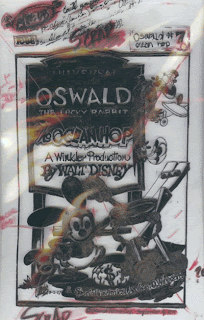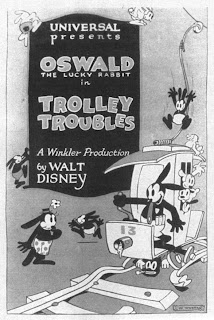How did you try to impress your childhood friends?
My best buddy in third grade was a cartoon fan, like me. We drooled over unaffordable cartoon collectibles that sat, just out of reach, at somber local antique shops. But even if I couldn't afford to own these pricey items, I reasoned, perhaps I could still fool my friend into thinking I owned one.
What was the earliest item of Disney merchandise? A 1929 Mickey Mouse school tablet. Right. What if I'd somehow found an even earlier tablet featuring Oswald the Lucky Rabbit? Of course! This would be easy.
At an art store, I bought the oldest, dingiest yellow construction paper I could find in a back room—so faded and smelly it had to be antique. Then I grabbed a pen and did my best to imitate Ub Iwerks. Wait till my friend saw this! In the words of Disney's later Brer Fox, "it sure gonna fool 'im..."
![]()
Except that in the words of Brer Bear, "it hain't gone fool nobody."
And here the story might have ended.
But for today, when we suddenly find similar fakes moving fast. Multiple Oswald the Lucky Rabbit "poster preliminaries" surfaced on eBay last year, where at least four sold and resold for what became small fortunes. Given my recent history of work with Oswald, several in the animation community have now approached me independently, asking for clarification—are these "preliminaries" authentic 1920s items? Aren't they?
![]()
I won't accuse any specific party of fakery here, because we can't be sure where the items really originated. Some have been rendered on cels, others on rice paper. All have the artwork rendered in elaborate, finished form with black areas (such as Oswald's fur) filled in very dark and solid. Most have extensive black shadowing under the characters. All also have elaborate, scattershot editorial notation added in red pencil. Some notes refer to approvals by Charles Mintz and/or Universal brass. Others indicate changes that were supposedly requested after this stage of the artwork.
![]() It would be interesting to discover that early Disney posters were developed via a multi-step approval system. But all other surviving evidence suggests they weren't. Actual Oswald-era poster sketches were simpler, more lightly-penciled affairs, such as the example for The Fox Chase (1928) at right. The real poster sketches didn't carry copious verbiage: Disney-to-Mintz communication was handled by letters and telegrams at the time. They weren't lavishly finished or inked; at an early stage in which ideas could still be discarded wholesale, there was no need to add excess detail.
It would be interesting to discover that early Disney posters were developed via a multi-step approval system. But all other surviving evidence suggests they weren't. Actual Oswald-era poster sketches were simpler, more lightly-penciled affairs, such as the example for The Fox Chase (1928) at right. The real poster sketches didn't carry copious verbiage: Disney-to-Mintz communication was handled by letters and telegrams at the time. They weren't lavishly finished or inked; at an early stage in which ideas could still be discarded wholesale, there was no need to add excess detail.
Beyond the historical reasons for why this doesn't add up, there are other means by which we can identify fabrications. Finished Oswald posters don't have extensive shadowing like these "preliminaries"; if huge shadows were never to be used in the end, why always include them at an earlier stage? Also, were the "preliminaries" really preliminaries, they would feature pencil construction lines—as seen, again, on Fox Chase—indicating how Oswald was built and the title lettering positioned. On the new "preliminaries," we don't usually see these lines; the art might as well have been traced from the poster reproductions in Russell Merritt and J. B. Kaufman's Walt in Wonderland (1993/2000).
And perhaps it was. Another central point about the newly-surfaced "preliminaries" is that while all 26 Disney Oswald cartoons had posters of their own, the new "preliminaries" all just happen to correspond to the specific handful reproduced in Wonderland. When the reproductions in Wonderland are damaged or incomplete in some way, the "preliminaries" mimic the effects of that damage on the image.
Here is the original one-sheet poster for Trolley Troubles (1927), as reproduced in a black-and-white photo from a major East Coast library collection. This is a rare version of the image, not reprinted anywhere to my knowledge. Gray linework represents elements that were originally outlined in color. Fanny (the girl rabbit) has a big smile. The sideboard containing the title is surrounded by a thin wooden border. The Bunny Kids (Oswald's swarm of children) crouched on top of the sideboard appear in full figure. The trolley bears a large number 13.
![]()
Now here is Trolley Troubles as reproduced in Wonderland, where it comes from Disney's long-held master image: a washed-out, highly faded copy of the earlier photo. This is the version we usually see. The color lines have disappeared, so we lose Fanny's mouth, the edge of the sideboard, the 13 on the trolley and most of the top Bunny Kid figures.
![]()
If a purported "preliminary" for an Oswald poster were genuine, it would include important design elements like mouths. But the newly-surfaced drawings always lack whatever their Wonderland equivalents lack. From Wonderland, for that matter, a forger could also have picked up some historical details for use in his/her red pencil notes.
Be on the lookout for animation art forgeries. They're not worth the high prices that a few of these unlucky rabbits have commanded. And fakery is a lot less endearing when you're a grown person than when you were in third grade.
![]()
Update, June 1: I've removed a photo of one Oswald drawing after receiving a complaint from its present owner. My goal here was merely to discuss the newly-surfaced images—not to embarrass anyone.
My best buddy in third grade was a cartoon fan, like me. We drooled over unaffordable cartoon collectibles that sat, just out of reach, at somber local antique shops. But even if I couldn't afford to own these pricey items, I reasoned, perhaps I could still fool my friend into thinking I owned one.
What was the earliest item of Disney merchandise? A 1929 Mickey Mouse school tablet. Right. What if I'd somehow found an even earlier tablet featuring Oswald the Lucky Rabbit? Of course! This would be easy.
At an art store, I bought the oldest, dingiest yellow construction paper I could find in a back room—so faded and smelly it had to be antique. Then I grabbed a pen and did my best to imitate Ub Iwerks. Wait till my friend saw this! In the words of Disney's later Brer Fox, "it sure gonna fool 'im..."

Except that in the words of Brer Bear, "it hain't gone fool nobody."
And here the story might have ended.
But for today, when we suddenly find similar fakes moving fast. Multiple Oswald the Lucky Rabbit "poster preliminaries" surfaced on eBay last year, where at least four sold and resold for what became small fortunes. Given my recent history of work with Oswald, several in the animation community have now approached me independently, asking for clarification—are these "preliminaries" authentic 1920s items? Aren't they?

I won't accuse any specific party of fakery here, because we can't be sure where the items really originated. Some have been rendered on cels, others on rice paper. All have the artwork rendered in elaborate, finished form with black areas (such as Oswald's fur) filled in very dark and solid. Most have extensive black shadowing under the characters. All also have elaborate, scattershot editorial notation added in red pencil. Some notes refer to approvals by Charles Mintz and/or Universal brass. Others indicate changes that were supposedly requested after this stage of the artwork.
 It would be interesting to discover that early Disney posters were developed via a multi-step approval system. But all other surviving evidence suggests they weren't. Actual Oswald-era poster sketches were simpler, more lightly-penciled affairs, such as the example for The Fox Chase (1928) at right. The real poster sketches didn't carry copious verbiage: Disney-to-Mintz communication was handled by letters and telegrams at the time. They weren't lavishly finished or inked; at an early stage in which ideas could still be discarded wholesale, there was no need to add excess detail.
It would be interesting to discover that early Disney posters were developed via a multi-step approval system. But all other surviving evidence suggests they weren't. Actual Oswald-era poster sketches were simpler, more lightly-penciled affairs, such as the example for The Fox Chase (1928) at right. The real poster sketches didn't carry copious verbiage: Disney-to-Mintz communication was handled by letters and telegrams at the time. They weren't lavishly finished or inked; at an early stage in which ideas could still be discarded wholesale, there was no need to add excess detail.Beyond the historical reasons for why this doesn't add up, there are other means by which we can identify fabrications. Finished Oswald posters don't have extensive shadowing like these "preliminaries"; if huge shadows were never to be used in the end, why always include them at an earlier stage? Also, were the "preliminaries" really preliminaries, they would feature pencil construction lines—as seen, again, on Fox Chase—indicating how Oswald was built and the title lettering positioned. On the new "preliminaries," we don't usually see these lines; the art might as well have been traced from the poster reproductions in Russell Merritt and J. B. Kaufman's Walt in Wonderland (1993/2000).
And perhaps it was. Another central point about the newly-surfaced "preliminaries" is that while all 26 Disney Oswald cartoons had posters of their own, the new "preliminaries" all just happen to correspond to the specific handful reproduced in Wonderland. When the reproductions in Wonderland are damaged or incomplete in some way, the "preliminaries" mimic the effects of that damage on the image.
Here is the original one-sheet poster for Trolley Troubles (1927), as reproduced in a black-and-white photo from a major East Coast library collection. This is a rare version of the image, not reprinted anywhere to my knowledge. Gray linework represents elements that were originally outlined in color. Fanny (the girl rabbit) has a big smile. The sideboard containing the title is surrounded by a thin wooden border. The Bunny Kids (Oswald's swarm of children) crouched on top of the sideboard appear in full figure. The trolley bears a large number 13.

Now here is Trolley Troubles as reproduced in Wonderland, where it comes from Disney's long-held master image: a washed-out, highly faded copy of the earlier photo. This is the version we usually see. The color lines have disappeared, so we lose Fanny's mouth, the edge of the sideboard, the 13 on the trolley and most of the top Bunny Kid figures.

If a purported "preliminary" for an Oswald poster were genuine, it would include important design elements like mouths. But the newly-surfaced drawings always lack whatever their Wonderland equivalents lack. From Wonderland, for that matter, a forger could also have picked up some historical details for use in his/her red pencil notes.
Be on the lookout for animation art forgeries. They're not worth the high prices that a few of these unlucky rabbits have commanded. And fakery is a lot less endearing when you're a grown person than when you were in third grade.

Update, June 1: I've removed a photo of one Oswald drawing after receiving a complaint from its present owner. My goal here was merely to discuss the newly-surfaced images—not to embarrass anyone.